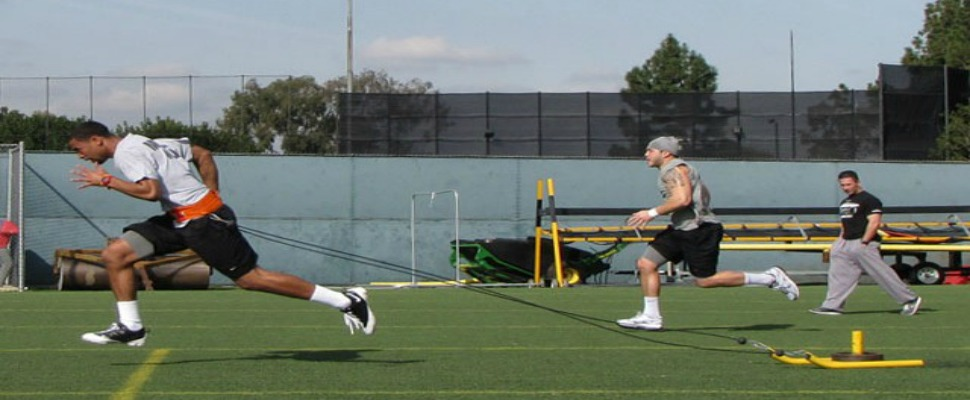
CONDITIONING
Endurance Potential
From Building Strength & Stamina-2nd Edition by Wayne Westcott, Nautilus Human Performance Systems
As with strength conditioning, everyone has the potential to improve cardiovascular endurance. In addition to age, gender, body build, and muscle fiber type, cardiovascular endurance is related to the ventilation capacity of the lungs, the pumping capacity of the heart, the distribution capacity of the blood vessels, and blood volume (the amount of blood within the circulatory system). All of these factors work together to supply your tissues with oxygen. The amount of oxygen needed for basic life processes is relatively small, but vigorous physical activity greatly increases the oxygen needs of your muscles.
Heart and Lung Capacity
When endurance athletes perform high-level aerobic exercise, their lungs may move more than 150 liters of air a minute, and their hearts may pump up to 40 liters of blood a minute. Relative to their body size, endurance athletes have larger lungs, hearts, and arteries than average individuals. They also have more blood vessels and greater blood volume than untrained people. Although endurance training can increase the ability of the muscles to use oxygen, its effect on the size of the heart and blood vessels is not fully understood. Most likely, outstanding endurance athletes are genetically endowed with exceptionally effective cardiovascular systems as well as with favorable muscle physiology.
Age
During your growth years, normal development increases the capacity of your cardiovascular system. However, once you reach adulthood, cardiovascular endurance gradually declines. One reason for this decline is that maximum heart rate steadily decreases with age, and this reduces the pumping capacity of your heart. As a rule, your maximum heart rate lowers about 10 beats a minute every decade. Even so, it is possible for those who haven’t been exercising to improve their cardiovascular fitness at any age and for those who do exercise regularly to maintain high levels of aerobic endurance throughout their midlife years.
Gender
Men typically perform better than women in endurance activities, such as distance running, cycling, and triathlons. This performance advantage is probably due to body composition differences between men and women. Male athletes generally have a higher percentage of lean weight and a lower percentage of fat weight than female athletes. Men probably do not have inherently superior cardiovascular systems compared with women. Endurance exercise seems to produce the same physiological adaptations in men and women, and both benefit from regular aerobic activity.
Body Build and Composition
Lower body weight is clearly an advantage for endurance activities, one reason almost all successful marathon runners have ectomorphic physiques. Closely related to body build is body composition-the ratio of fat weight to lean weight, expressed as percent body fat. At a given body weight, people with a lower percentage of fat weight and a higher percentage of lean weight have an advantage in endurance performance. One way to increase your aerobic ability is to achieve a lower percentage of body fat through endurance exercise, strength training, and proper diet.
Muscle Fiber Types
The oxygen-receiving capacity of the muscles affects endurance potential as much as the oxygen-delivering capacity of the cardiovascular system. However, not all muscle fibers utilize oxygen in the same way. Slow-twitch muscle fibers use oxygen more efficiently and resist fatigue better than fast-twitch fibers. Slow-twitch muscle fibers are best suited to endurance exercise, while fast-twitch muscle fibers are best suited to brief bouts of strength exercise.
Strength exercise improves muscular fitness. A strong musculoskeletal system increases physical performance, reduces risk of injury, and enhances appearance. Certain genetic characteristics, however, influence your strength potential.
Fortunately, men and women of all ages can improve their muscle strength through a progressive program of resistance exercise. Even if you do not make a major change in your body build as a result of strength training, you will still reap major fitness benefits. Stronger muscles, bones, tendons, and ligaments increase your ability to perform physical activity and decrease the risk of musculoskeletal injuries and degenerative diseases. Youths, adults, and seniors all benefit from systematic strength exercise. This is good news because muscle strength is a key factor for overall health and fitness.
Likewise, aerobic exercise improves cardiovascular fitness. An efficient cardiovascular system benefits both physical performance and health. Even though factors such as age and basic body build influence endurance potential, people of all ages can enhance cardiovascular endurance through a regular program of aerobic activity.
People who are overweight generally avoid aerobic activities because they find less satisfaction and success in endurance exercise than strength training. But overweight and heavily muscled people should keep in mind that endurance exercise is an excellent way to burn extra calories. Endurance exercise also provides extra protection against heart disease.
Just as a well-maintained engine and fuel system keep an automobile running well, tuned-up muscular and cardiovascular systems will improve your physical strength and endurance. A combination of strength and endurance fitness will increase your energy level, make you feel and look better, and help you stay healthy longer--all of which will enhance your quality of life.
Endurance Potential
From Building Strength & Stamina-2nd Edition by Wayne Westcott, Nautilus Human Performance Systems
As with strength conditioning, everyone has the potential to improve cardiovascular endurance. In addition to age, gender, body build, and muscle fiber type, cardiovascular endurance is related to the ventilation capacity of the lungs, the pumping capacity of the heart, the distribution capacity of the blood vessels, and blood volume (the amount of blood within the circulatory system). All of these factors work together to supply your tissues with oxygen. The amount of oxygen needed for basic life processes is relatively small, but vigorous physical activity greatly increases the oxygen needs of your muscles.
Heart and Lung Capacity
When endurance athletes perform high-level aerobic exercise, their lungs may move more than 150 liters of air a minute, and their hearts may pump up to 40 liters of blood a minute. Relative to their body size, endurance athletes have larger lungs, hearts, and arteries than average individuals. They also have more blood vessels and greater blood volume than untrained people. Although endurance training can increase the ability of the muscles to use oxygen, its effect on the size of the heart and blood vessels is not fully understood. Most likely, outstanding endurance athletes are genetically endowed with exceptionally effective cardiovascular systems as well as with favorable muscle physiology.
Age
During your growth years, normal development increases the capacity of your cardiovascular system. However, once you reach adulthood, cardiovascular endurance gradually declines. One reason for this decline is that maximum heart rate steadily decreases with age, and this reduces the pumping capacity of your heart. As a rule, your maximum heart rate lowers about 10 beats a minute every decade. Even so, it is possible for those who haven’t been exercising to improve their cardiovascular fitness at any age and for those who do exercise regularly to maintain high levels of aerobic endurance throughout their midlife years.
Gender
Men typically perform better than women in endurance activities, such as distance running, cycling, and triathlons. This performance advantage is probably due to body composition differences between men and women. Male athletes generally have a higher percentage of lean weight and a lower percentage of fat weight than female athletes. Men probably do not have inherently superior cardiovascular systems compared with women. Endurance exercise seems to produce the same physiological adaptations in men and women, and both benefit from regular aerobic activity.
Body Build and Composition
Lower body weight is clearly an advantage for endurance activities, one reason almost all successful marathon runners have ectomorphic physiques. Closely related to body build is body composition-the ratio of fat weight to lean weight, expressed as percent body fat. At a given body weight, people with a lower percentage of fat weight and a higher percentage of lean weight have an advantage in endurance performance. One way to increase your aerobic ability is to achieve a lower percentage of body fat through endurance exercise, strength training, and proper diet.
Muscle Fiber Types
The oxygen-receiving capacity of the muscles affects endurance potential as much as the oxygen-delivering capacity of the cardiovascular system. However, not all muscle fibers utilize oxygen in the same way. Slow-twitch muscle fibers use oxygen more efficiently and resist fatigue better than fast-twitch fibers. Slow-twitch muscle fibers are best suited to endurance exercise, while fast-twitch muscle fibers are best suited to brief bouts of strength exercise.
Strength exercise improves muscular fitness. A strong musculoskeletal system increases physical performance, reduces risk of injury, and enhances appearance. Certain genetic characteristics, however, influence your strength potential.
Fortunately, men and women of all ages can improve their muscle strength through a progressive program of resistance exercise. Even if you do not make a major change in your body build as a result of strength training, you will still reap major fitness benefits. Stronger muscles, bones, tendons, and ligaments increase your ability to perform physical activity and decrease the risk of musculoskeletal injuries and degenerative diseases. Youths, adults, and seniors all benefit from systematic strength exercise. This is good news because muscle strength is a key factor for overall health and fitness.
Likewise, aerobic exercise improves cardiovascular fitness. An efficient cardiovascular system benefits both physical performance and health. Even though factors such as age and basic body build influence endurance potential, people of all ages can enhance cardiovascular endurance through a regular program of aerobic activity.
People who are overweight generally avoid aerobic activities because they find less satisfaction and success in endurance exercise than strength training. But overweight and heavily muscled people should keep in mind that endurance exercise is an excellent way to burn extra calories. Endurance exercise also provides extra protection against heart disease.
Just as a well-maintained engine and fuel system keep an automobile running well, tuned-up muscular and cardiovascular systems will improve your physical strength and endurance. A combination of strength and endurance fitness will increase your energy level, make you feel and look better, and help you stay healthy longer--all of which will enhance your quality of life.
Train for Stamina
CONDITIONING













